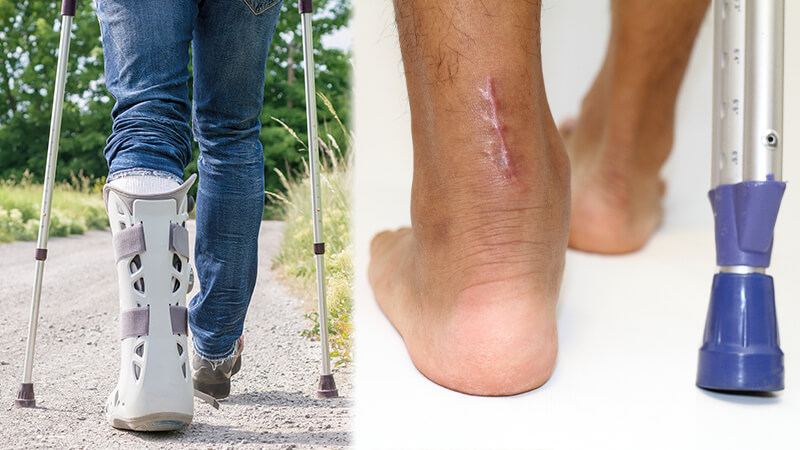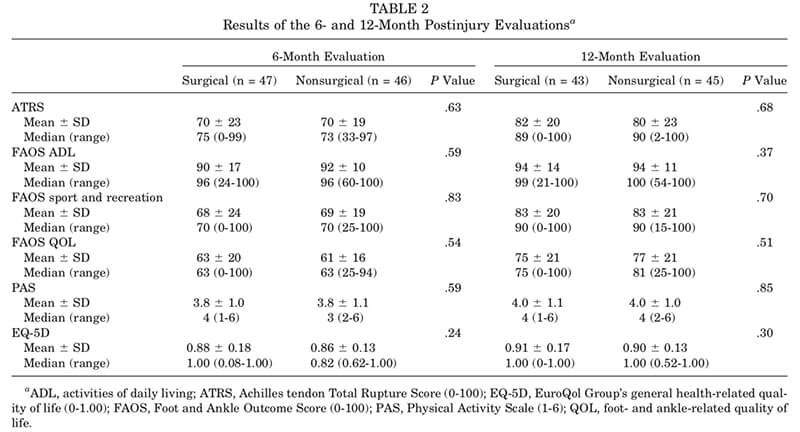Residency Insight
Can Patients with Achilles Tendon Ruptures Start Immediate Protected Weight Bearing and Accelerated Rehab Protocol?
Can Patients with Achilles Tendon Ruptures Start Immediate Protected Weight Bearing and Accelerated Rehab Protocol?

Reference
Olsson N, Silbernagel KG, Eriksson BI, et al. Stable surgical repair with accelerated rehabilitation versus nonsurgical treatment for acute Achilles tendon ruptures: a randomized controlled study. Am J Sports Med. 2013 Dec;41(12):2867-76.
Link to Original Article
https://www.ncbi.nlm.nih.gov/pubmed/24013347
Design/Level
Randomized Control Trial
Purpose
Evaluate early loading of the tendon and ROM training and see if it can improve patient reported outcome and function after a total acute Achilles tendon rupture, comparing surgical and nonsurgical treatment.
Methods
- 100 patients in randomized controlled study. Diagnosed clinically. Excluded if rupture older than 4 days and prior Achilles tendon rupture on either leg. Randomized via computer generated sealed envelopes.
- Surgical treatment: 49 patients, 1/10 orthopaedic surgeons. Modified Kessler technique. Operated in prone position without tourniquet. Posterolateral skin incision. No cast was used. They were placed in CAM walker with 3 heel pads to obtain 22 degree angle. Full WB. Early rehab started at 2 weeks postop.
- Nonsurgical treatment: 51 patients. Treatment with same CAM boot with 3 heel pads. Full WB.
- F/U: 2, 6, 26 weeks in surgical group and 8, 26 weeks in nonsurgical group. Clinical evaluation, MRI if needed. Patient-reported outcome data in this study were collected using a web-based protocol.
Results/Discussion
- Patient Reported Outcome and physical activity, functional evaluation with 2 jump tests.
- There were no statistically significant differences between the 2 treatment groups at 3, 6, and 12 months as evaluated by the Achilles tendon Total Rupture Score (ATRS), and both groups improved significantly over time at the 3-, 6-, and 12-month evaluations (Table 2).

- There were no significant differences in physical activity level between the groups’ preinjury level or at 6 and 12 months (Table 2). Furthermore, no significant differences were found in physical activity level when comparing the preinjury level with the level at 12 months either in the surgical group (P = .78) or in the nonsurgical group (P = .23).
- QOL scores improved significantly over time between 3, 6, and 12 months
- Functional tests not significant except hopping and drop countermovement jump at 12 months was improved in nonsurgical more than surgical (significant)
- Complications: no re-ruptures in surgical group, 5 patients in non-surgical group had a re-rupture. All 5 patients were surgically treated with augmentation.
- DVT in one surgical patient and 2 non-surgical.
- 6 surgical patients with superficial wound infection.
Conclusion
Stable surgical repair with accelerated tendon loading could be performed in all (n = 49) patients without re-ruptures and major soft tissue–related complications. However, this treatment was not significantly superior to nonsurgical treatment in terms of functional results, physical activity, or quality of life.
Relevance
Patients with Achilles tendon ruptures are often treated surgically. Literature has shown favorable results for protected weightbearing. The American Academy of Orthopaedic Surgeons (AAOS) guidelines also recommends early protected postoperative weightbearing. Accelerated rehab is controversial in the literature, especially with weight bearing on day 0. This study brings to light new information on immediate weightbearing postop day 0. Patients did well in their accelerated protocol and the randomized controlled nature of the study helps compare the surgical and nonsurgical groups. Patients who underwent conservative treatment had a 10% re-rupture rate. However, all other outcomes seemed comparable to the surgical group. This study can help practitioners determine a new accelerated protocol that allows for earlier weight bearing and rehabilitation.
Link to Original Article
https://www.ncbi.nlm.nih.gov/pubmed/24013347



Comments
There are 0 comments for this article